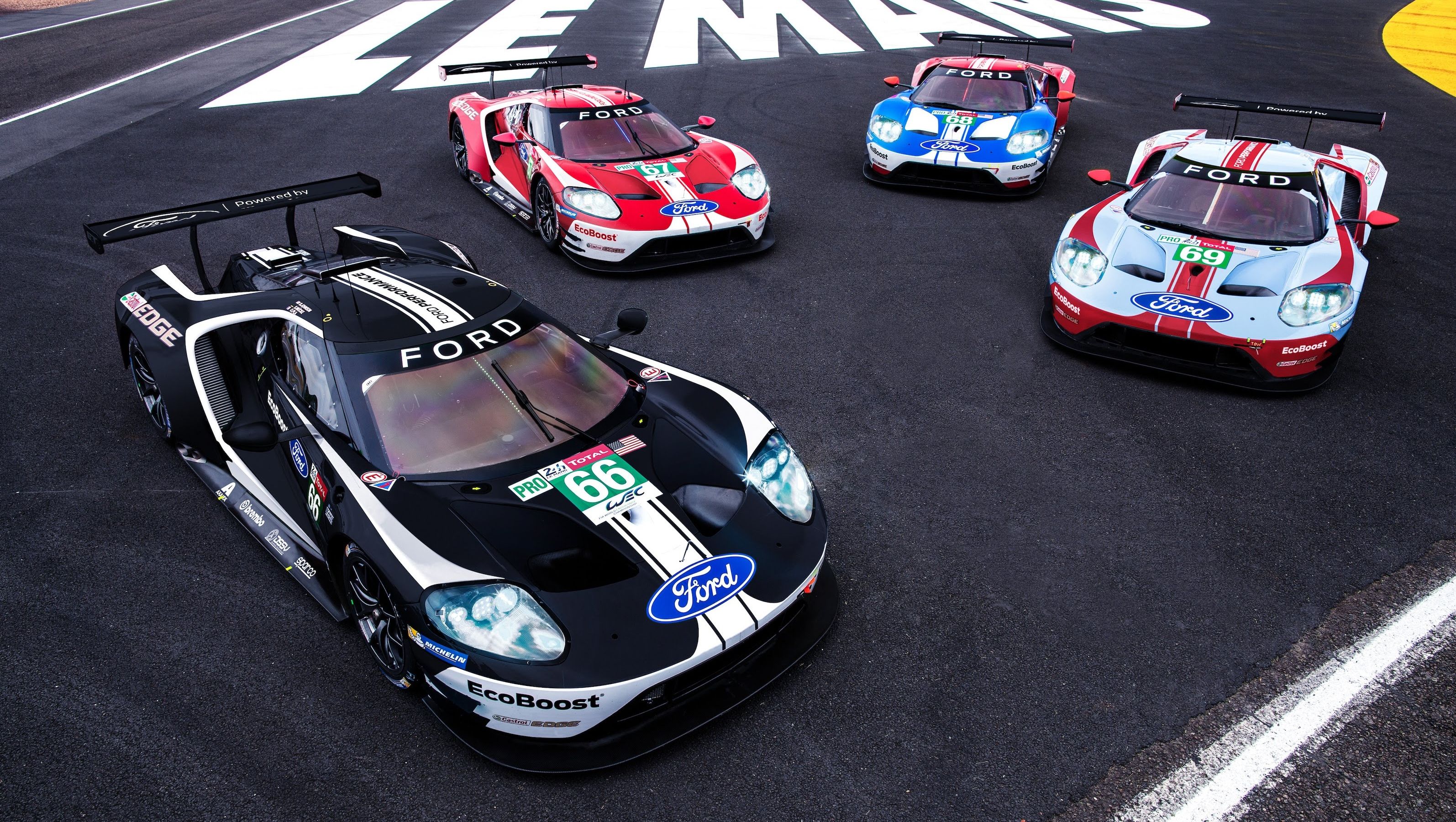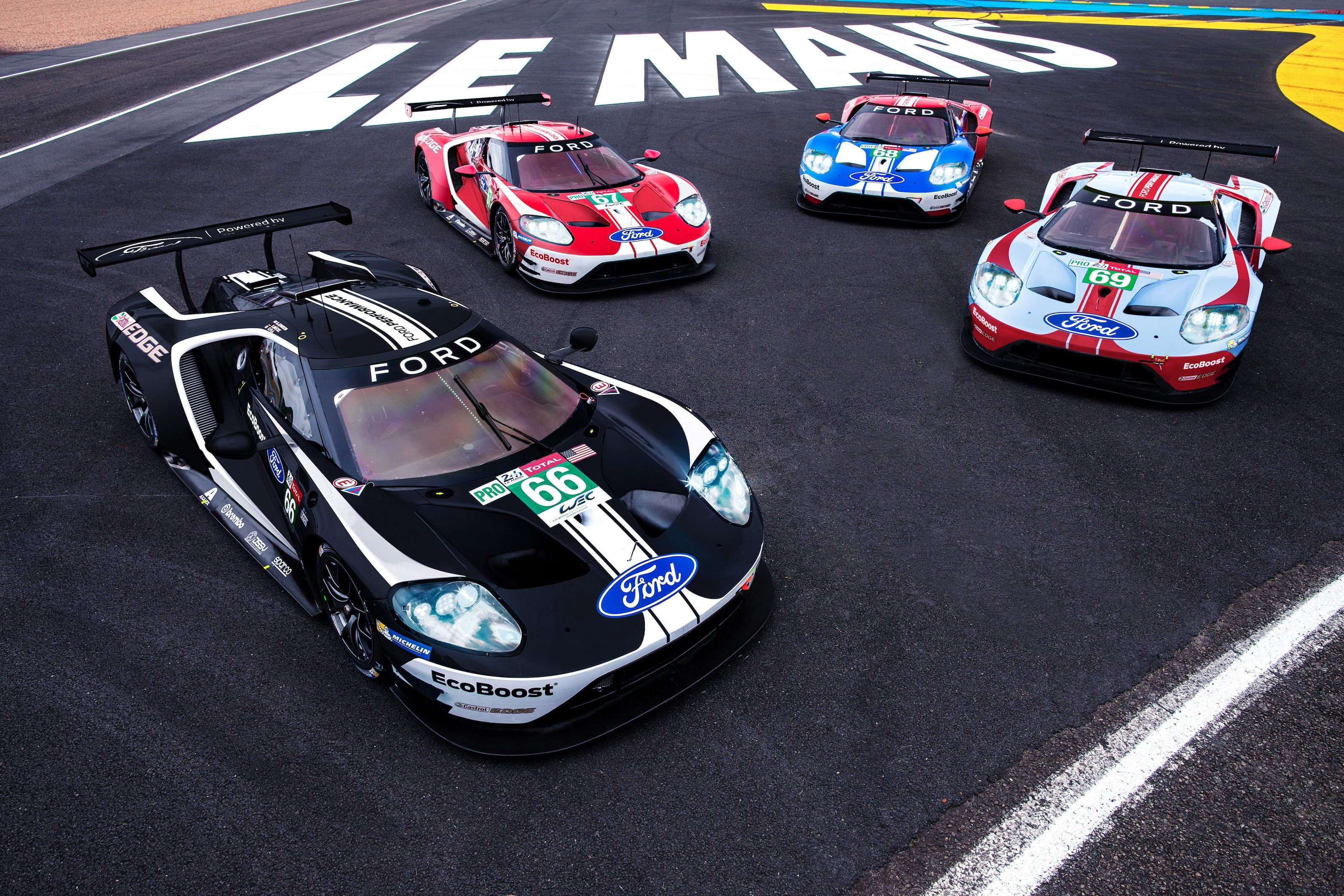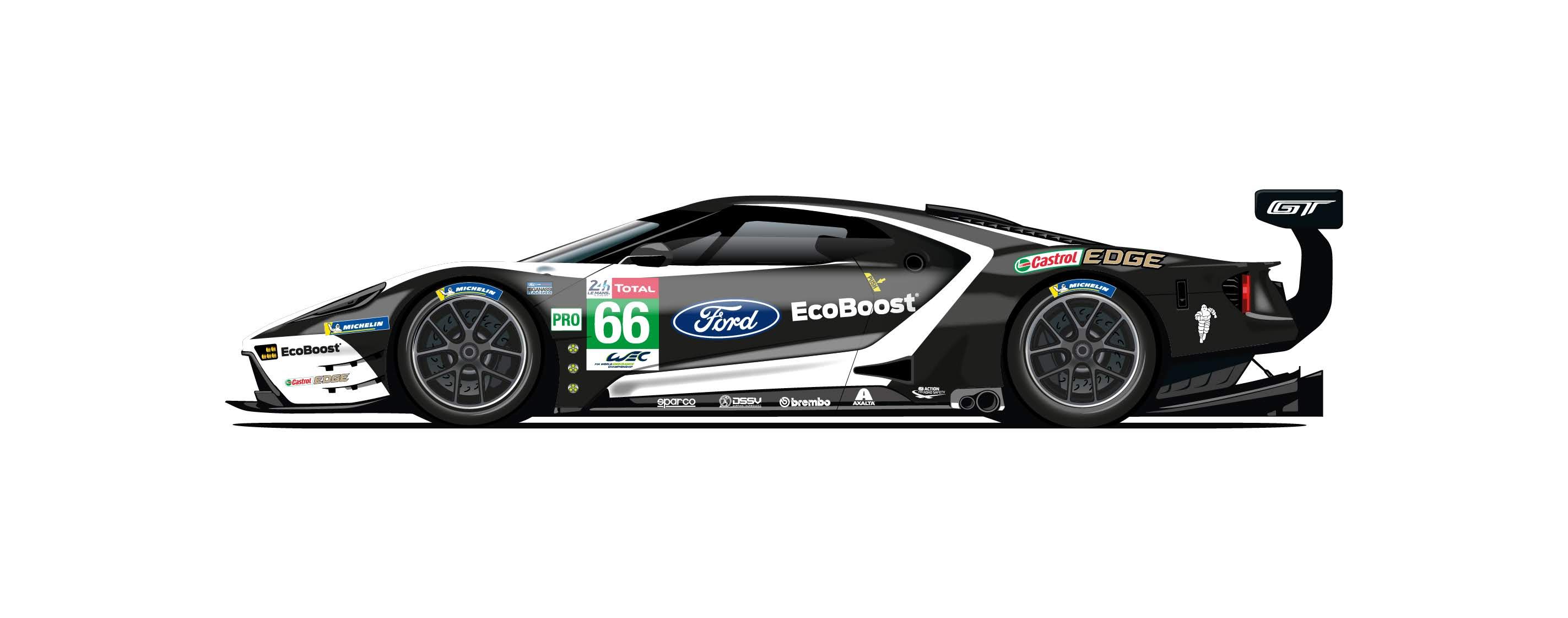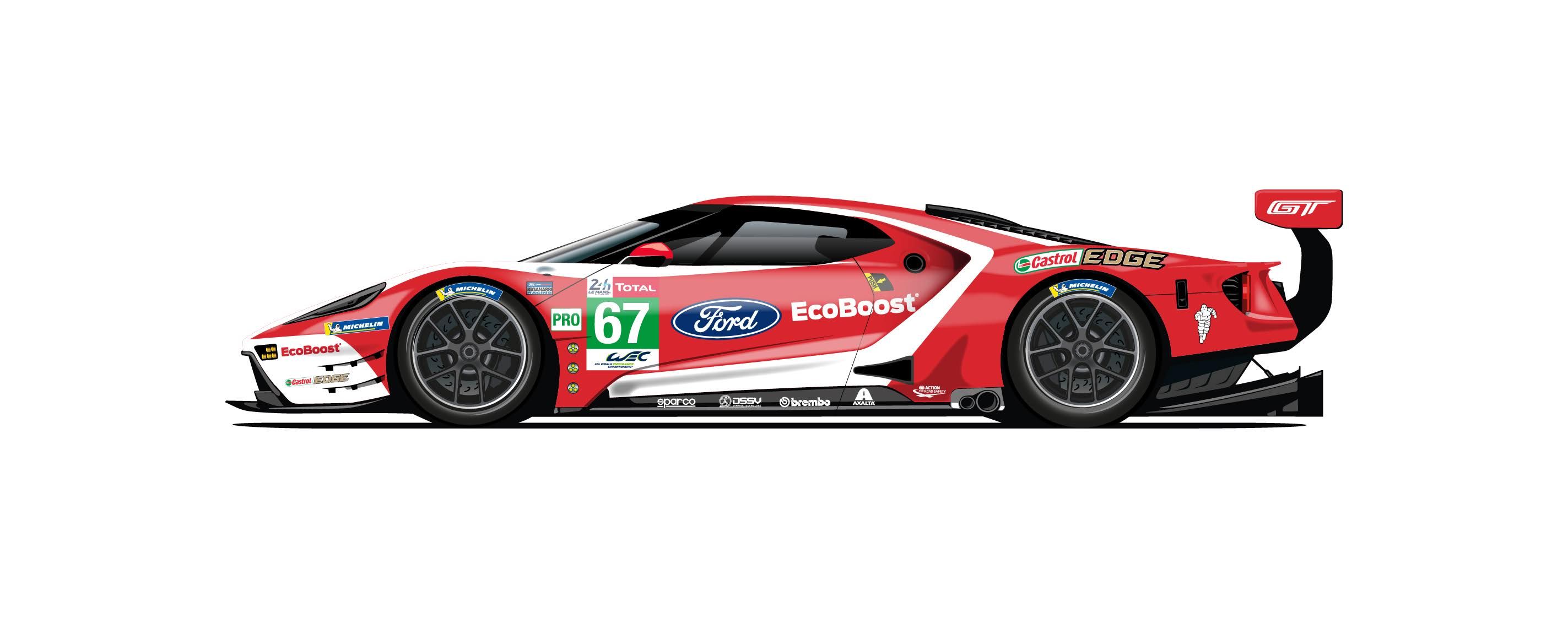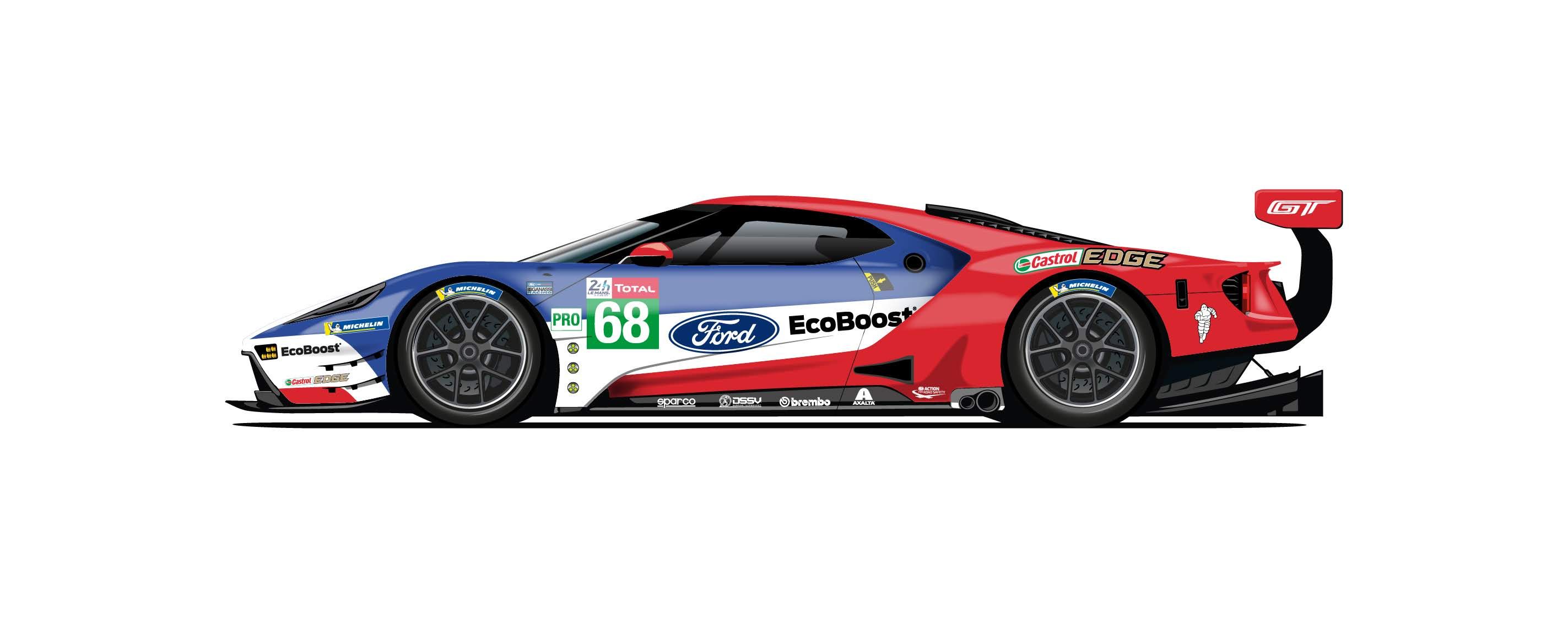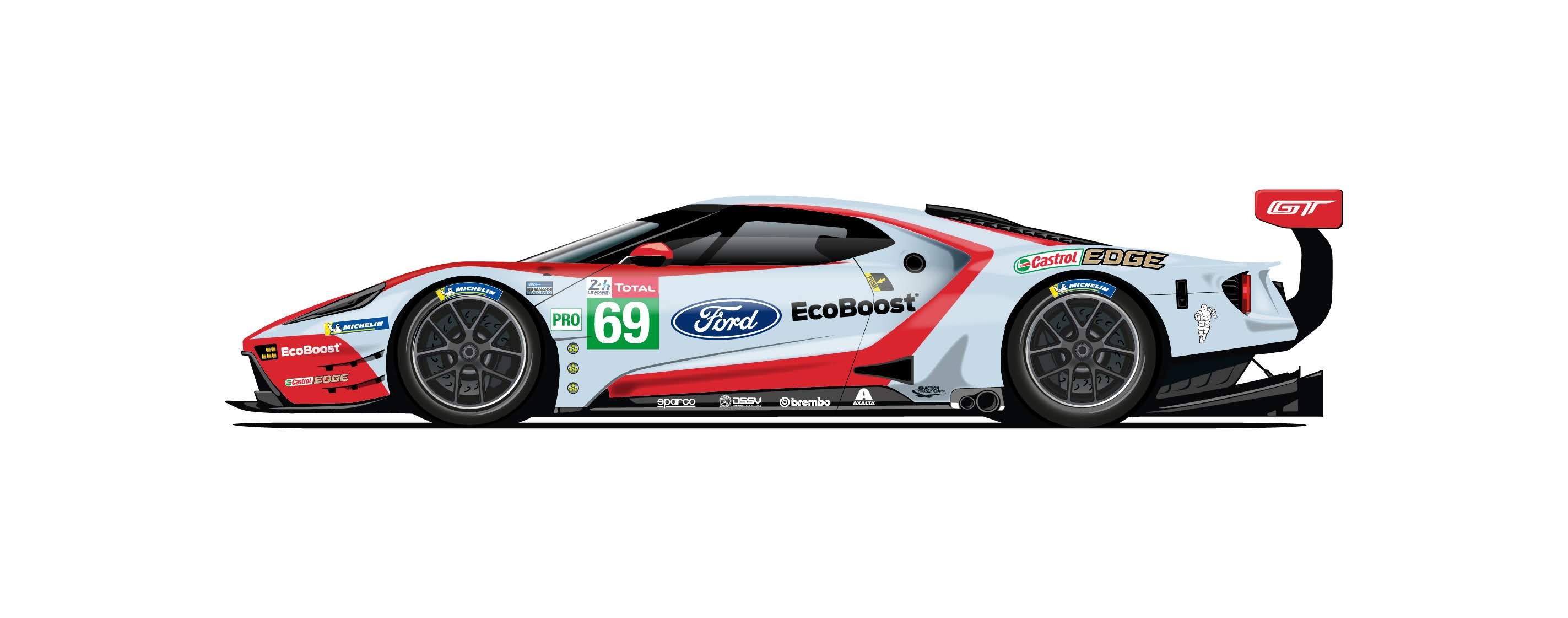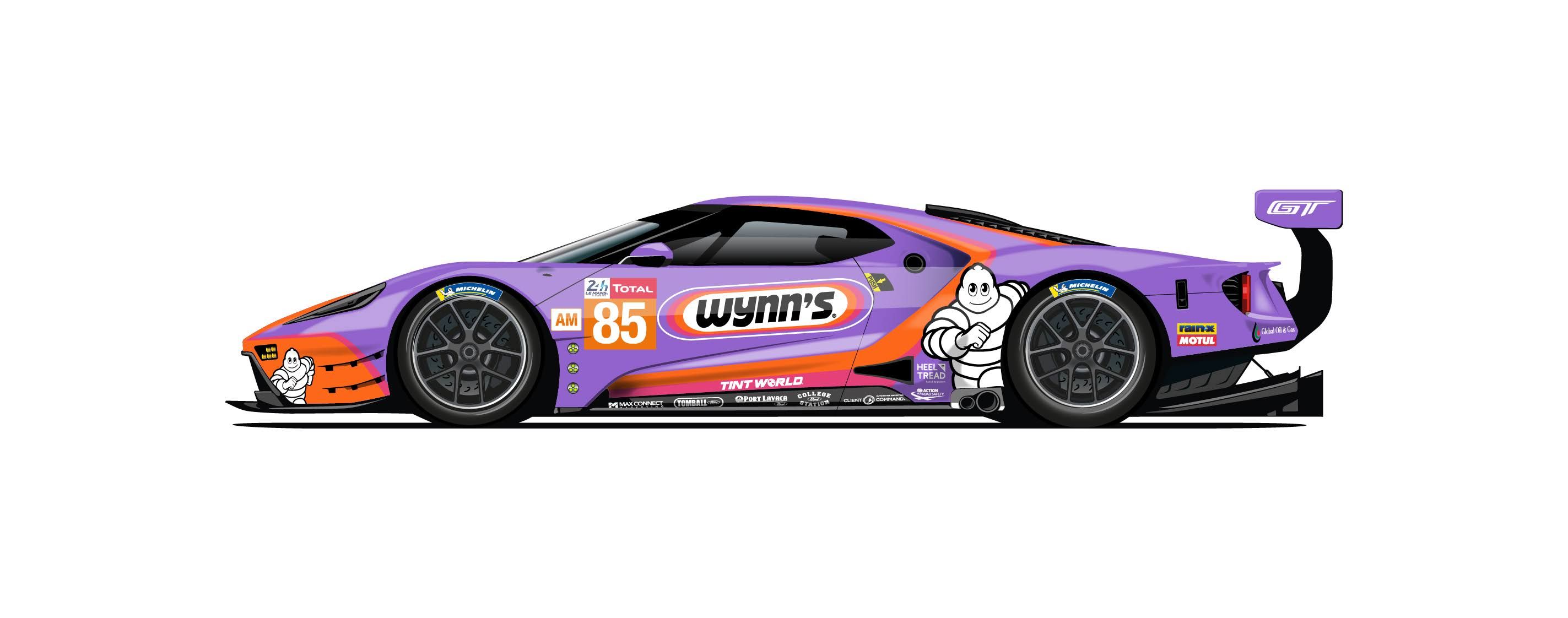The Ford GT in racing trim is both one of the most successful and one of the most controversial GT racing cars of the past decade. Having debuted in 2016 when the road car was yet to see the gleaming floors of a dealership, the GTE-spec Ford GT will retire as a factory race car after this year's 24 Hours of Le Mans race, the final round of the 2018-2019 FIA World Endurance Championship Super-Season. The good news is that it'll do it by giving a final tribute to its forerunners from half a century ago.
We're less than a month away from this year's 24 Hours of Le Mans, the 87th running of the most famous sports car endurance race in the world. Last year, Porsche wowed the crowds with a pair of retro-liveried Porsches, namely the No. 91 Manthey Racing entry that sported a Rothmans-inspired color scheme and the No. 92 Manthey Racing entry that threw it back to 1971 and the emblematic Porsche 917/20 'Pink Pig.' A full year has gone by and, now, it is Ford's turn to delve into its storied past. If Porsche's performance last year (a pole with the No. 91 car in the hands of Gianmaria Bruni and the victory in the GTE-Pro class with the No. 92 squad) is any indication of how retro-liveried entries fare at Le Mans, the Ford works program will end with a bang.
The 2016 Ford GT LM comes with a unique story beyond its legendary stablemates
The Ford GT, at its origins, is the result of one man's fury and his decision to beat another man at his own game. That first man was Henry Ford II, and the other's name was Enzo Ferrari. You all know the story, and it's even going to hit the big screen this Fall with Matt Damon and Christian Bale in the leading roles. With Ford pouring unlimited (and, to this day, unknown) amounts of dough into the program, Ferrari's reign at Le Mans came to an abrupt end while Ford's GT won four times on the trot in various guises and that was that.
The 20th century came and went without a proper revival of the GT nameplate but, in the early '00s, during that retro craze that seemed to infect most of the American manufacturers (cough, Chrysler PT Cruiser, Chevrolet SSR, the '05 Mustang, and the list goes on), the idea of a modern-day GT emerged and so did a surprisingly self-conscious prototype. Why self-conscious? Because it looked almost like a carbon copy of the old car. If that stands as proof that the original design was way ahead of its time is up for debate but what's certain is that the prototype created enough of a stir to push Ford to make it a reality - unlike the video game-bound GT90 that was stillborn.
The 2005 Ford GT was Ford's halo car in the noughties but, in spite of its popularity at launch, it didn't sell all that well and, when the production run ended, we thought we'll never see another Ford GT ever again. But we were wrong.
We first thought the new car would debut at the 2016 24 Hours of Le Mans, precisely 50 years since the Blue Oval first won at Circuit de la Sarthe with an Mk. II driven by Bruce McLaren and Chris Amon of New Zealand. It soon became apparent, however, that this wasn't going to happen since you can't debut at the race you're planning to win and actually think you're going to pull through with it. As a result, Ford devised an ambitious plan: it would race a total of four GTE/GTLM-spec Ford GTs in two championships so that four would be eligible to compete at Le Mans - more than any other manufacturer had in the GT ranks.
The first two would compete under the watchful eye of Chip Ganassi Racing in the American IMSA-sanctioned Weathertech Sports Car Championship while two others will compete on the global stage under the direction of Chip Ganassi Racing U.K. in the FIA World Endurance Championship. The American arm of the program debuted at the 24 Hours of Daytona, a grueling race in and of itself, while the European one kicked-off at Silverstone for the six-hour race before racing at Spa.
The reason for that is that Ford miraculously got its act together in a matter of months - in January, at Daytona, both cars struggled with transmission issues - and quite simply obliterated the star-studded field in the GTE-Pro class at Le Mans. Why did this see Ford get criticized from every angle? Well, because, nowadays, to keep everything fair and square in GT racing, sanctioning bodies use a system called Balance of Performance that aims to have all the cars on a leveled playing field regardless of the design of the car, its engine, and its original output. That's how a (formerly) rear-engined Porsche 911 could race against a front-engined Corvette C7 and a mid-engined Ferrari 488 quite cheerfully and share wins between one another although this is almost impossible to achieve on the road with the street-going versions that are massively different machines. That's not to say the racing cars aren't, but the BoP manages to keep everything in line by altering each car's maximum boost pressure, maximum power output, torque output, its weight, or the amount of air that can be sucked in by the intakes. It's a delicate game of walking on a thin piece of rope between success and awful failure and, as with everything, there are winners and losers at every corner.
But the margin of Ford's victory at Le Mans in 2016 got the losers properly angry. In fact, only one car from one team - the Risi Competizione-entered Ferrari 488 GTE - was able to stay with the four Ford GTs all race long and it even managed to steal away a picture-perfect result from under the nose of the Blue Oval by coming home in second overall behind one Ford and ahead of two others that were there to replicate the 1-2-3 victory of 1966.
How big was Ford's leap and why were there allegations of sandbagging in the two WEC rounds that predated Le Mans? For starters, it must be said that sandbagging allegations plagued the 2016 season since it kicked-off with all of the GT cars (both in the GTLM and the GTD categories) accused of holding back and hiding their hands during the Roar Before The Daytona 24 pre-season test. Only then did the issue of Ford sandbagging arise. Since I'm all about comparing apples with apples and not apples with oranges, I'm just going to talk about Ford's progress between the Le Mans Test Day in early June of 2016 and the qualifying session for the 24-hour race a couple of weeks later.
This pushed organizers to hastily alter the BoP the day before the race - something that really does not happen - but it did little to help Corvette, Porsche, and Aston Martin that were all second-class citizens come race day. Ford was quick to fight back saying it never really did qualifying-like runs in practice and was unaware of the car's genuine pace when running with low fuel and fresh rubber. Still, after 24 hours, the Fords (and that sole Ferrari) were two laps ahead of everyone else in the GTE-Pro class.
Initially, 2017 was to be Ford's last year with the GT works program as 1967 was also the year when Dearborn's involvement in top-flight prototype racing ended because the Group 5 category in which the Mk. II and the Mk. IV had competed in was altered to allow the entry of large-volume prototypes and not bespoke machines due to the organizers wanting to switch focus to the slower 3.0-liter prototype category. But the Le Mans victory in 2016 got everyone so ecstatic that the program was extended all the way to 2019 - the year of the 50th anniversary of Ford's last Le Mans win and the second to come in the hands of a privateer team.
The classic liveries on the 2016 Ford GT LM will see it bow out in style
Sadly for Ford fans, there will be no extra extension to the GT's works program and, as such, June's 24 Hours of Le Mans will be the last European race for the car while the last American race will take place in October at Road Atlanta, namely the traditional Petit Le Mans 10-hour enduro that ends both the IMSA Weathertech Sports Car Series and the Michelin North-American Endurance Cup. Sure, we might see Ford GTs race beyond the end of this season but not in works capacity. Already, for Le Mans, Ben Keating's team is preparing a GT that will be entered in the GTE-Am category in Wynn's colors.
The No. 66 car will be driven by Stefan Muecke, Olivier Pla, and Billy Johnson sports a black design with white stripes reminiscent of the colors of the No. 2 Shelby American Inc. 1966 Ford Mk. II that won by the slightest of margins over the No. 1 car driven by Ken Miles and Denny Hulme. 1966 was the third year of the Ford GT program, and it came after two rather dismal seasons marred by crashes (some of them deadly), mechanical failures, and a general lack of pace. The original Mk. I Ford GT40 developed by Ford Advanced Vehicles in England using expertise from Lola Cars' founder Eric Broadley was an absolute failure. The aerodynamics were all over the place, meaning that the car was awfully unstable and wobbly at speed and the nose would lift above 180 mph.
What is more, the 4.7-liter V-8 originally used in the Cobra didn't cut it, and the Ferraris had the upper hand as all three Fords retired at Le Mans. Then, in 1965, Henry Ford II ditched his British partners and entrusted the program to Carroll Shelby who was already busy building and racing the Cobra Roadster and the Cobra Coupe that went on to become GT World Champion that year with driver Bob Bondurant. Shelby's tenacity could be seen from the word go as the Ford GT40, still in Mk. I specification and with the 289 C.I. engine in the middle but, otherwise, heavily revised around the front end, won the first race of the year at Daytona.
Then, at Le Mans, Ford introduced the Mk. II GT40 which was powered by the gargantuan 7.0-liter engine. Chris Amon & Co. were blindingly fast in practice but the cars (two of them) retired and, again, Ferrari won thanks to the N.A.R.T. 250 LM of Masten Gregory and Jochen Rindt. Finally, in '66, Ford went all in and brought no less than eight updated Mk. IIs with brand-new bodywork. The cars had proven themselves in the first 24-hour race held at the Daytona roval and at the 12 Hours of Sebring where the unique open-top version of the Mk. II won after Dan Gurney's car was disqualified due to the fact that the AAR founder tried to push the car across the line. Ferrari showed up at Sebring, but its trip to Florida ended in tears after the works 330 P3 crashed and killed a marshal. Ferrari would skip the '67 edition of the 12-hour race for that very reason.
Due to the fact that the No. 2 started further back than the No. 1 car, the No. 2 car was declared the winner over the No. 1 as the winner, in those days, was the car that'd covered the biggest distance. This was incredibly frustrating for Briton Ken Miles who had his lead erased in the final hour by team orders and then lost the win due to a gimmicky rule thus denying him the unofficial Triple Crown of endurance racing (after victories at Sebring and Daytona). Sadly, Miles perished later that same year while testing the J car at Riverside, in California.
Ferrari also won on home ground at Monza, but Ford could care less as its focus was solely on Le Mans. Four Mk. IVs arrived in the La Sarthe valley, and they were rockets. With Amon's Ferrari burning to the ground due to a collapsed suspension that ignited the rear bodywork, Ford only had to fight the conditions to finish, and it wasn't easy as, again, it rained. The winning pair was made up of Dan Gurney - who established the practice of spraying champagne on the rostrum - and A.J. Foyt. Foyt, a Le Mans rookie, barely had any time to get to grips with the car and his first laps were in practice when he learned the track driving behind Denny Hulme. In spite of his seemingly limitless courage, even Foyt noted that the tall trees that lined the Mulsanne straight were harrowing given the Mk. IV would pass them at about 220 mph at full chat. But he could still joke about it saying that the white paint on the tree trunks was there so that rescue teams could easily spot how far a car had scattered into the first in the case of a high-speed crash on the straight.
The two won with an average speed of 135 mph through rain and fog and beat Ferrari's best (an Ecurie National Belge-entered P4) by more than a few laps. Then it was all over. FISA banned low-production +5.0-liter prototypes and, for 1968, decided to focus on 3.0-liter prototypes. As such, all cars that had big engines had to be made in big numbers. Originally, the number was 50 but, then, it was lowered to 25, and that's how the Lola T70 and the old Ford GT40 Mk. I became eligible to race in what was now known as the Sports car +5.0-liter category.
With Ford out of the picture officially, the best-prepared Fords could be found in the yard of one John Wyer, the former team boss of Aston Martin in the days when the British team conquered Le Mans (1959). He'd struck a deal with Gulf Oils thanks to Grady Davis' relationship with Dick Thompson who raced a Gulf-sponsored Mk. I in the 12 Hours of Sebring with Jacky Ickx. Both of them drove that year the team's updated Mk. I known as the Mirage M1. Since it wasn't a Mk. I, it couldn't compete in 1968 in the World Championship and, as such, the John Wyer Automotive reverted back to the 'stock Mk. I with the 289 C.I. engine in it.
Of course, the British team modified a lot of stuff on the Mk. I, most prominently being the large rear fenders that housed significantly fatter tires than those used in '65-'66. The car was effective but failed to win at both Daytona and Sebring. Then, it took home victories at Brands Hatch and Monza and finished third at the Nordschleife, a track that never suited the big GT40. Due to a strike, the Le Mans race was postponed for a Fall date and, in the meantime, Wyer's boys won at Spa and at Watkins Glen.
In September, the No. 9 car (chassis #1075) won in the hands of Belgian Lucien Bianch and Mexican Pedro Rodriguez to cap off a successful year. 1969 was also good but, by then, there were other cars to watch. A Lola entered by Roger Penske won at Daytona, Ford shot back with victory at Sebring (where Penske's Lola was stolen and promptly dismantled pushing Penske to miss Le Mans), but it was Porsche who dominated. Indeed, the Wiessach boys were bored with just winning in the lower classes at Le Mans and had been working on their long tail prototypes since 1966.
The Belgian, cunningly, had previously tricked the German into thinking he was either running on fumes or running out of brakes since he was trailing and braking very early and also getting off the throttle in places you wouldn't normally do so. It was all done just to make Herrmann think the victory was his before the fact. When, with a few laps to spare, Ickx pounced and went by, Herrmann had no response and, for the second year on the trot, chassis #1075 won Le Mans.
This was the GT40's final Le Mans win and the No. 69 Ford GT LM (that'll be shared by Scott Dixon, Ryan Briscoe, and Richard Westbrook) reflects those colors but, at the same time, due to the red stripes, it's also a nod to Ken Miles' Mk. II from 1966 which was painted in powder blue with red stripes a full year before Gulf Oils arrived on the scene and first sponsored a Ford GT40.
As I said, there'll also be, for the very first time, a Ford GT in the GTE-Am ranks. Keating Motorsports will enter the car prepared by Riley, who's also running Keating's IMSA Weathertech Sports Car Championship Mercedes-AMG entry in the GTD class. The drivers will be Ben Keating himself, his long-time friend and partnered Jeroen Bleekemolen and Felipe Fraga.
The 2019 Le Mans Test Day will take place this weekend, and we already know what manufacturers are the winners and which are the losers in terms of the BoP before the test. It's important to note that this year's Le Mans race also marks the final WEC start of the BMW Motorsport operation that's set to pull out of the WEC before the start of the 2019-2020 FIA WEC season. BMW will, however, still be present Stateside with the Rahal Letterman-Lanigan Racing team in GTLM with the same BMW M8 GTEs you'll see at Le Mans.
Further reading
Read our full review on the 2017 Ford GT.
Read our full review on the 2019 Ford GT Heritage Edition
Read our full review on the 2019 Ford GT Carbon Edition.
Read our full review on the 1964 - 1969 Ford GT40.
Read our full review on the 2005 - 2006 Ford GT.

